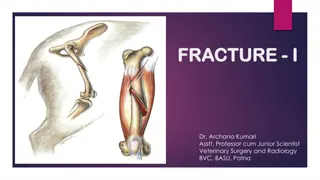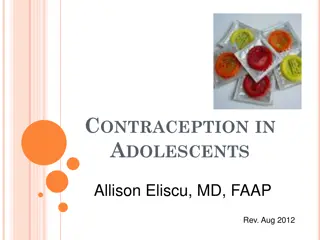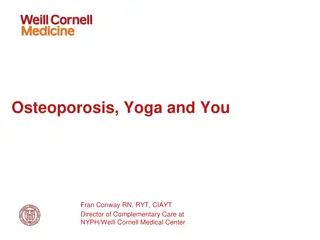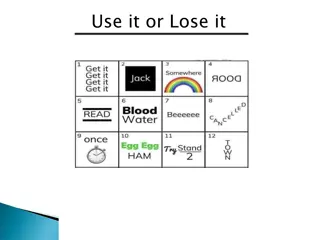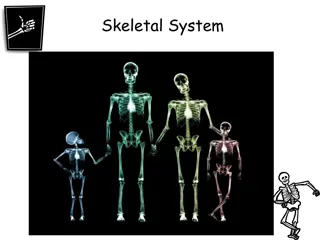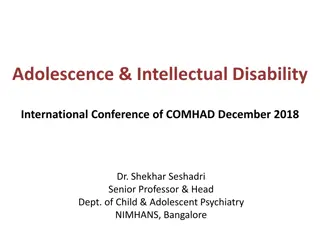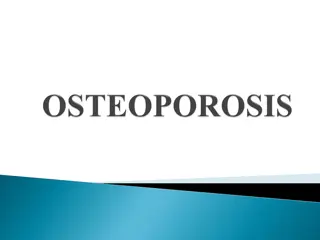Understanding Peak Bone Mass and Bone Health in Adolescents
Discussing the importance of peak bone mass in adolescents for bone strength and the prevention of osteoporosis. Topics include factors influencing peak bone mass, interventions to optimize bone health, and risks associated with poor nutrition and eating disorders.
Download Presentation

Please find below an Image/Link to download the presentation.
The content on the website is provided AS IS for your information and personal use only. It may not be sold, licensed, or shared on other websites without obtaining consent from the author. Download presentation by click this link. If you encounter any issues during the download, it is possible that the publisher has removed the file from their server.
E N D
Presentation Transcript
Nutrition and Bone Health Golaleh Asghari, PhD Nutrition and Endocrine Research Center
Lets Discuss Peak bone mass Calcium and vitamin D Other nutrients and dietary factors Bone loss Osteoporosis
Peak Bone Mass Bone strength reflects the integration of bone mineral density (BMD) and other properties of bone that are collectively called "bone quality". BMD in adults is determined by peak bone mass and subsequent bone loss. In one analysis, for every one standard deviation decrease in BMD at the hip, there was a 2.6-fold increase in the risk of hip fracture. Thus, the prevention of low bone mass is directed to maximizing peak bone mass and minimizing the rate of bone loss, with the ultimate goals of maintaining bone strength and preventing fractures. Osteoporosis prevention, diagnosis, and therapy. JAMA; 2001. Marshall D et al; BMJ; 1996.
Peak Bone Mass (cont.) The statement of Professor Charles Dent: Osteoporosis is a pediatric disease the importance of achieving the maximum potential peak bone mass, thereby attenuating the effects of bone loss later in life. Dent CE; Proceedings of the International Symposium on Clinical Aspects of Metabolic Bone Disease; 1973.
Peak Bone Mass (cont.) Peak bone mass: the maximum bone mass achieved in life Interventions to optimize peak bone mass should be directed toward a healthy lifestyle during the bone-forming years, particularly adolescence. These can be divided into categories of: Nutrition Physical activity Other lifestyle factors E Michael Lewiecki; Prevention of osteoporosis; 2019.
Peak Bone Mass (cont.) All children, and in particular, adolescents, should have Good nutrition with particular attention to calcium and vitamin D intake Engage in regular physical activity Achieve normal body weight Avoid smoking and alcohol use E Michael Lewiecki; Prevention of osteoporosis; 2019.
Peak Bone Mass (cont.) Anorexia nervosa An increasingly common eating disorder in female adolescents Is associated with reduced BMD and increased fracture risk Other nutritional disorders Inflammatory bowel disease Celiac disease Cystic fibrosis
Calcium and vitamin D Adequate daily intake of calcium and vitamin D, is a key component in the attainment of maximum peak bone mass. Children 9 to 18 years of age should consume approximately 1300 mg of calcium daily, preferably from calcium-rich or calcium-fortified foods. Adequate vitamin D (600 IU) is necessary to promote intestinal calcium absorption. E Michael Lewiecki; Prevention of osteoporosis; 2019. Esterle L et al; J Bone Miner Res; 2010.
Calcium and vitamin D (cont.) Routine supplementation of calcium and vitamin D is not necessary for healthy growing children who consume a varied diet. For those unable to achieve adequate intake from diet, we suggest supplementation with calcium and vitamin D. Esterle L et al; J Bone Miner Res; 2010.
Calcium and vitamin D (cont.) However, the skeletal benefits of calcium and vitamin D supplements have been difficult to demonstrate in clinical trials, which may be due, in part, to the design of the trials. Most trials evaluated short-term supplementation in healthy children who did not have inadequate dietary intake of calcium and vitamin D. Supplementation is likely to benefit only those children with inadequate intake. In such children, longer-term follow-up is required to show a substantial benefit in bone mineralization and fracture prevention. Esterle L et al; J Bone Miner Res; 2010.
Calcium and vitamin D (cont.) In a meta-analysis of 19 randomized trials (2800 healthy children): A small increase in total body mineral content in children assigned to calcium supplementation (300 to 1200 mg daily for 0.7 to 7 years) rather than placebo (mean difference 0.14, 95% CI: 0.01-0.27) No differences in BMD at the femoral neck or lumbar spine. Winzenberg TM et al; Cochrane Database Syst Rev; 2006.
Calcium and vitamin D (cont.) In observational studies: Serum vitamin D levels were positively associated with bone density in children and adolescents. In a meta-analysis of six randomized trials (800 healthy children and adolescents): No difference in total bone mineral content or hip, forearm, or lumbar spine BMD in children randomly assigned to vitamin D supplementation or placebo. Winzenberg T et al; Calcif Tissue Int; 2013. Winzenberg T et al; BMJ; 2011.
Sesame Seeds There is a controversy on calcium content of sesame seeds One tablespoon of hulled sesame seeds contains 88 mg calcium. Hulled Un-hulled One tablespoon of un-hulled sesame seeds contains 37 mg (about 60% less).
Sesame Seeds (cont.) Nutrient Energy Protein Total lipid (fat) Carbohydrate Fiber, total dietary Sugars, total Calcium, Ca Iron, Fe Magnesium, Mg Phosphorus, P Potassium, K Sodium, Na Zinc, Zn Vitamin D Unit kcal g g g 1Value per 100 g 573 17.73 49.67 23.45 1 cup = 144.0g 825 25.53 71.52 33.77 1 tbsp = 9.0g 52 1.6 4.47 2.11 g 11.8 17 1.1 g 0.3 975 14.55 351 629 468 11 7.75 0 0.43 1404 20.95 505 906 674 16 11.16 0 0.03 88 1.31 32 57 42 1 0.7 0 mg mg mg mg mg mg mg IU United States Department of Agriculture. Agricultural Research Service National Nutrient Database for Standard Reference Legacy Release
Relationship of calcium absorption fraction to vitamin D nutritional status [as measured by serum 25(OH)D]. Note that efficiency rises up to 25(OH)D levels of approximately 80 nmol/L (32 ng/ml), above which regulation of absorption is no longer limited by vitamin D status.
Vitamin D Vitamin D guidelines have been issued by major organizations worldwide: World Health Organization (WHO) International Osteoporosis Foundation (IOF) Institute of Medicine (IOM) Endocrine Society (ES) American Association of Clinical Endocrinologists (AACE) European Association of Medical Doctors The ES and IOM guidelines were formulated after an extensive review of the literature, used similar predefined outcomes of mineral metabolism, yet reached differing conclusions in terms of desirable 25OHD level, set at 30 ng/mL by ES and 20 ng/mL by IOM. They also differed in recommended doses to reach them, varying between 600 and 800 IU for IOM, and 600 and 2000 IU for ES Bouillon R, et al; J Clin Endocr Metab.; 2013.
Vitamin D (cont.) The differences in desirable 25OHD levels derived by the IOM and ES may in part be explained by different target populations they addressed, the general public versus the patient in the clinic. Furthermore, the defined desirable 25OHD levels, and required vitamin D doses to reach them, do not take into account the wide individual variations around the mean Race calcium intake renal function body mass index polymorphisms in key protein/enzymes Ghada El-Hajj Fuleihan et al; Journal of Bone and Mineral Research; 2015.
Desirable range for serum 25OHD level Beneficial effects on fall and fracture risk at levels > 20 ng/mL with the upper confidence limits of 40 ng/mL, with no additional benefit for any bone health outcome in serum 25OHD level >40 ng/mL. Well-documented vitamin D toxicity with serum 25OHD level >100 ng/ mL. Proposed desirable range (20-40 ng/mL), takes into account the currently evidence, put in the context of common sources of variations and uncertainties, and avoids the use of a single cutoff. Although slightly lower levels (15-20 ng/mL) may be sufficient for some infants and adults, higher levels (40 to 60 ng/mL) may still be safe. Ghada El-Hajj Fuleihan et al; Journal of Bone and Mineral Research; 2015.
Vitamin K Recommended intake 120 g/day for men and 90 g/day for women Sources of vitamin K Synthesized by bacteria in the large intestine Green leafy vegetables (kale, spinach, collard greens, lettuce)
Phosphorus High in protein-containing foods such as Milk Meats Eggs legumes In processed foods as a food additive (phosphate salt): Smoothness Binding Moisture retention In soft drinks as phosphoric acid
Magnesium Recommended intake RDA varies based on age and gender UL (pharmacological): 350 mg/day Sources of magnesium Green leafy vegetables, whole grains, seeds, nuts, seafood, beans, some dairy products Dietary protein enhances absorption and retention
Magnesium (cont.) What if you consume too much? Excess supplements cause diarrhea, nausea, cramps, dehydration, acid base imbalances Hyper magnesemia occurs in individuals with impaired kidney function (antacid) What if you don't consume enough? Hypomagnesemia: results in hypocalcemia; associated with osteoporosis, heart disease, high blood pressure, type 2 diabetes
Other dietary factors and peak bone mass (cont.) High consumption of carbonated soft drinks may impair bone acquisition and increase fracture risk in girls. A matter of displacement of more nutritious beverages and that it may be reversed by taking the recommended daily intake of calcium. High soft drink consumption in the adolescent population contributes to low calcium intake by displacing milk consumption rather than higher phosphate intake. Whiting SJ et al J Nutr; 2004. McGartland C et al; J Bone Miner Res; 2003.
Other dietary factors and peak bone mass (cont.) Another hypothesis: rapid rate of phosphorus absorption and greater phosphorus bioavailability from processed foods such as cola drinks. Those at high risk and those who have osteoporosis may want to avoid these beverages Calvo MS et al; Ann NY Acad Sci ; 2013.
Other dietary factors and peak bone mass (cont.) Excessive caffeine intake may have a deleterious effect on BMD. Intake of colas also is associated with lower BMD. Although the primary issue may be displacement of dairy beverages, there is also a potential direct effect.
High acid or alkaline diets Higher acid diets include those high in protein, dairy, and grains. It is theorized that these higher acid diets may increase calcium excretion and have a detrimental effect on bone. The theory also supports a converse beneficial effect of an alkaline diet on bone. Several meta-analyses, experimental studies, and reviews have not supported either the negative effect of higher acid diets on bone or the positive effects of an alkaline diet on bone. Hanley DA et al; J Clin Densitom; 2013.
Nutrition and Peak Bone Mass (cont.) Interventions to promote calcium consumption among youth should be initiated early and focus not only on increasing dairy product intake but also on decreasing intakes of soft drinks and increasing intakes of other calcium-rich foods such as: 1. fortified orange juice 4. other grains 2. ready-to-eat cereals 5. dark leafy green vegetables 3. enriched breads 6. tofu prepared with calcium sulfate Ranjit et al; 2010. Hallstrom H et al; Nutr Metab ; 2010.
Bone loss Stabilizing BMD or reducing the rate of bone loss is the primary objective in the prevention of osteoporosis a pyramid approach to the prevention and treatment of osteoporosis with a foundation of lifestyle changes that include nutrition, physical activity, and fall prevention a second tier of addressing drugs and diseases associated with bone loss or osteoporosis a third tier of pharmacologic therapy US Department of Health and Human Services, Office of the Surgeon General. Bone Health and Osteoporosis: A Report of the Surgeon General; 2004.
Bone loss (cont.) Factors influencing rate and magnitude of bone loss: Concomitant diseases Hormone concentrations Age Body weight Calcium and vitamin D intake Physical activity Family history Alcohol consumption Cigarette smoking E Michael Lewiecki; Prevention of osteoporosis; 2019.
Osteoporosis In 1997: The European Foundation for Osteoporosis and Bone Disease published guidelines for the diagnosis and management of osteoporosis In 2008 and 2013: Updated by the IOF and European Society for Clinical and Economic Evaluation of Osteoporosis and Osteoarthritis. Kanis JA et al, The European Foundation for Osteoporosis and Bone Disease, 1997 Kanis JA et al, European guidance for the diagnosis and management of osteoporosis in postmenopausal women, 2008 Kanis JA et al, European guidance for the diagnosis and management of osteoporosis in postmenopausal women, 2013
Osteoporosis (cont.) Osteoporosis is a systemic skeletal disorder characterized by a decrease in bone mass and micro architectural deterioration of bone tissue. The World Health Organization has defined osteoporosis as a decrease in bone mass (50%) and bony quality (50%). J.A. Kanis et al; Bone Miner. Res;1994.
Osteoporosis (cont.) Idiopathic osteoporosis due to aging and postmenopausal status is the most comment form. However, the dysregulated bone remodeling and formation due to systemic disease alter the bone turnover and induce secondary osteoporosis G.R. Emkey et al; Clin. Endocrinol. Metab; 2014.
Lifestyle and osteoporosis adequate nutrition regular weight bearing physical activity (30 minutes on most days of the week) smoking cessation no or moderate alcohol intake fall prevention E Michael Lewiecki; Prevention of osteoporosis; 2019.
Nutrition and Osteoporosis Calcium & vitamin D are important throughout the life span Fruit and vegetable consumption associated with improved bone health; good sources of vitamins C and K, magnesium Protein effect on bone health is controversial High intake may increase calcium loss Low protein intake also associated with bone risks Sodium: high intakes appear to have a negative impact, but studies are inconclusive
Nutrition and Osteoporosis (cont.) Most randomized controlled trials evidence for the efficacy of interventions based on co-administration of the agent with calcium and vitamin D supplements Combined calcium (0.5 1.2 g) and vitamin D (400 800 IU) supplements are generally recommended in patients receiving bone protective therapy
Nutrition and Osteoporosis (cont.) The 2018 US Preventive Services Task Force recommended against supplementation with 400 IU vitamin D and 1000 mg calcium for the primary prevention of fractures in postmenopausal women Insufficient evidence to assess the benefits and harms at doses higher than these. Institute of Medicine; Dietary reference intakes for calcium and vitamin D; 2010. Grossman DC et al; JAMA; 2018.
Take home messages Peak bone mass and bone loss are both important for BMD Calcium and vitamin D intakes based on RDA is necessary for maximizing peak bone mass Desirable range of 25OHD is 20-40 ng/mL Other nutrients including vitamin K, phosphorus, magnesium are important for bone health Combined supplementation of calcium and vitamin D is recommended for osteoporosis treatment Supplementation of calcium and vitamin D is not necessary for primary prevention of osteoporosis









